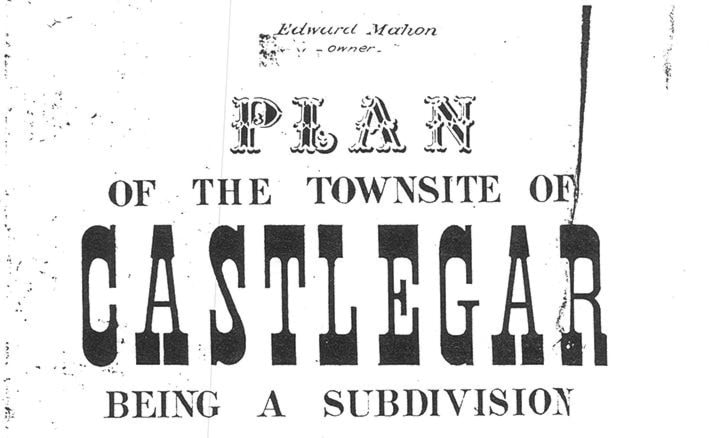Thirtieth in a nearly alphabetical series on West Kootenay/Boundary place names
Last week we began looking at the origin of Castlegar, named by founder Edward Mahon after his Irish ancestral home.
We left off in 1897 just as Mahon had laid out the townsite and closed a deal with mining magnate Augustus Heinze to develop Castlegar together, with Heinze contributing land from his railway grant.
Mahon didn’t know Heinze was simultaneously negotiating with someone else: early the following year, he sold his smelter, railway charter, and interest in Castlegar to the Canadian Pacific Railway.
The company wasn’t known for joint real estate ventures and things quickly bogged down. In 1899, Mahon sold all even-numbered blocks in the townsite to the railway, further ensuring any development would require their agreement.
To make matters worse, a portion was carved up for the approach to the railway bridge across the Columbia River. Yet Mahon doesn't appear to have given up yet, for in 1901 he set aside a couple of lots for an hotel that was never built.
The bridge’s completion the following year spurred the early growth of what was then known as Castlegar Junction, with the first buildings sprouting up around the railway station in the portion of town that came from Heinze’s land grant. Mahon’s contribution to the townsite remained undeveloped.
The stalemate persisted for another decade, during which time Castlegar was the subject of litigation between Heinze and the CPR. Finally in 1912, Mahon transferred his remaining lots to his brother John. By now, he had moved to Vancouver where his business pursuits proved much more successful — including the purchase of the Capilano suspension bridge.
His involvement in the Castlegar townsite was already long forgotten, for when James White of the Geographic Survey of Canada inquired in 1905 about the origin of Castlegar’s name, postmaster William J. Farmer responded:
“The place called Castlegar was called into existence some two years ago by the CPR, who made a junction here, previous to which time, there was no settlement. From what I can gather, the name originated from some building which was erected at the time of railway construction, resembling in some way the structure called Castle Garden, where emigrants land in New York; anyway, I fear from an historical point of view, Castlegar is far too new to interest anyone.”
For more on the development of the Castlegar townsite, see Walter Volovsek’s The Green Necklace: The Vision Quest of Edward Mahon.
Next week: A mystery solved
Previous installments in this series
Applegrove, Appleby, and Appledale revisited
Bakers, Birds, and Bosun Landing
Bannock City, Basin City, and Bear Lake City
Boswell, Bosworth, Boulder Mill, and Broadwater
Brooklyn, Brouse, and Burnt Flat
Camborne, Cariboo City, and Carrolls Landing
